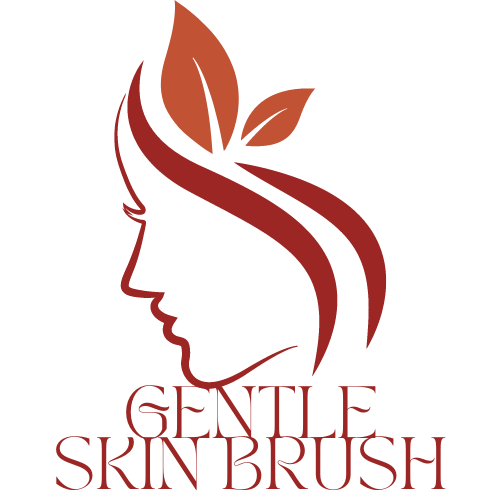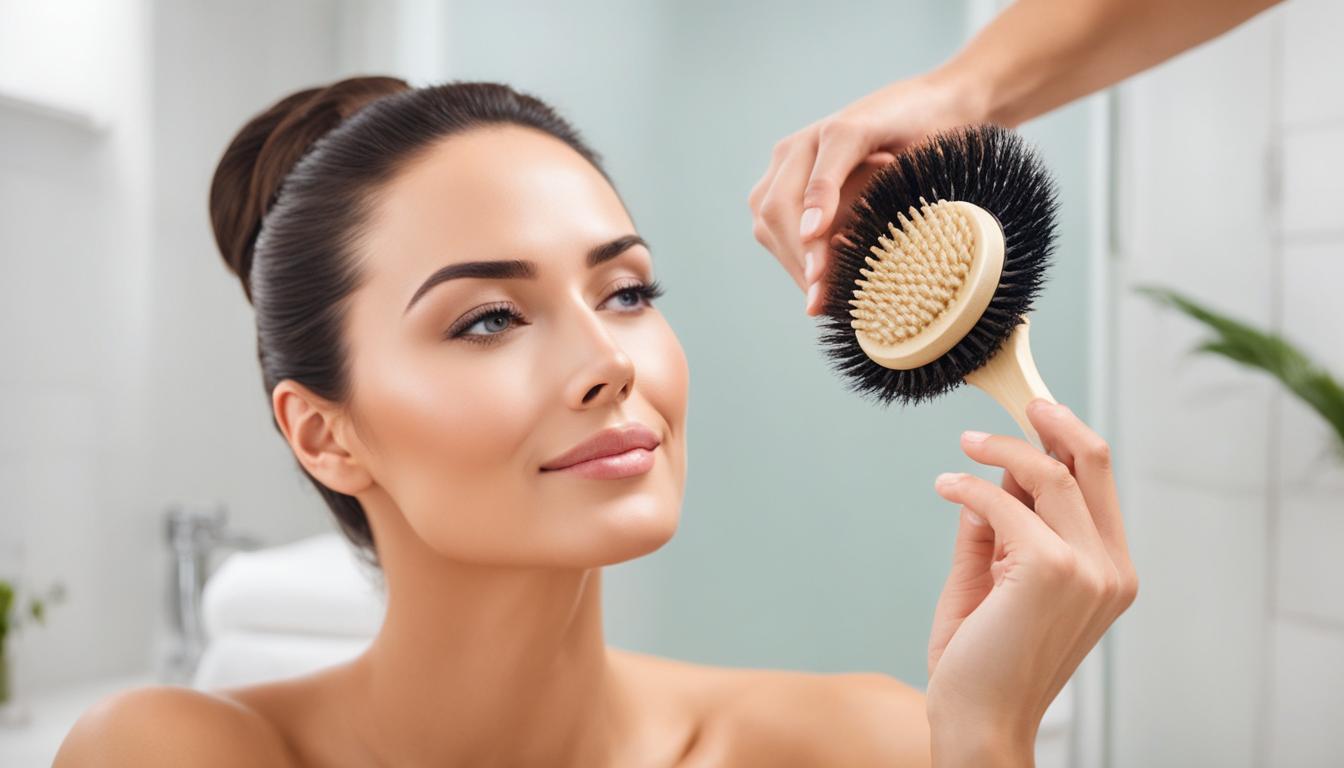Dry brushing for eczema has become a popular technique due to its potential benefits for managing this skin condition. Eczema, also known as atopic dermatitis, is a chronic inflammatory condition that causes red, itchy, and dry patches on the skin. By understanding how dry brushing can potentially help with eczema, you can decide if it’s a suitable addition to your skincare routine.
Contents
Key Takeaways:
- Dry brushing can increase blood flow, circulation, and detoxification of the skin.
- It helps keep the skin clean and free from buildup, which is essential for managing eczema flare-ups.
- Precautions include using a soft brush designed for dry skin and avoiding brushing during flare-ups or areas of infection.
- Thoroughly cleaning and sanitizing the brush is crucial to prevent bacteria buildup.
- Consulting a dermatologist is recommended for individuals with sensitive skin or other skin conditions.
The Benefits of Dry Brushing for Eczema Relief
Dry brushing is a technique that offers several benefits for eczema relief. When done correctly, it can help exfoliate the skin, remove dead skin cells, and enhance the absorption of moisturizers. The gentle brushing motion stimulates blood flow, which in turn hydrates the skin, delivers essential nutrients, and promotes healing.
One of the primary advantages of dry brushing is its ability to maintain cleaner and stronger skin. By removing built-up debris and toxins, dry brushing contributes to a detoxified complexion. This can be particularly beneficial for individuals with eczema, as it supports the management and prevention of flare-ups.
Dry brushing also provides an opportunity for self-care and relaxation. The repetitive brushing motion can be soothing and therapeutic, helping to relieve stress and promote overall well-being. Incorporating dry brushing into your skincare routine, along with other eczema management techniques, can help optimize your skin’s health and enhance your quality of life.
Table: The Benefits of Dry Brushing for Eczema Relief
| Benefits | Description |
|---|---|
| Exfoliates the skin | Removes dead skin cells, promoting a smoother texture |
| Enhances absorption of moisturizers | Allows for better penetration of hydrating products |
| Stimulates blood flow | Improves circulation, delivering nutrients and promoting healing |
| Supports detoxification | Removes toxins and helps maintain a cleaner complexion |
| Promotes relaxation | Offers a soothing and therapeutic self-care practice |
Remember, it is essential to follow precautions when dry brushing with eczema. Ensure you are using a soft brush specifically designed for dry skin and avoid brushing over areas of active flare-ups or infection. If you have sensitive skin or other skin conditions, it is advisable to consult a dermatologist before incorporating dry brushing into your routine.
Overall, dry brushing can be a valuable addition to your eczema management plan. Take the time to explore this technique, adjust it to suit your skin’s needs, and enjoy the potential benefits it offers for eczema relief.
Precautions for Dry Brushing with Eczema
Dry brushing can be a helpful technique for managing eczema, but it’s important to take certain precautions to ensure it doesn’t worsen your condition or cause any discomfort. Here are some tips to follow for safe and effective dry brushing with eczema:
- Choose an eczema-friendly brush: Opt for a soft brush specifically designed for dry skin. This type of brush is gentler on the skin and less likely to cause irritation or damage.
- Avoid brushing during flare-ups: When your eczema is flaring up or if you have areas of infection, it’s best to avoid dry brushing those areas. The bristles of the brush can aggravate the skin and potentially worsen the flare-up.
- Be cautious with sensitive skin: If you have sensitive skin or other skin conditions, proceed with caution when dry brushing. It’s recommended to consult a dermatologist before incorporating dry brushing into your skincare routine to ensure it’s suitable for your skin.
Listen to your skin: Pay attention to how your skin reacts to dry brushing. If you experience any irritation, redness, or discomfort, adjust the technique or frequency of dry brushing accordingly. Your skin’s health and comfort should always be a priority.
“Dry brushing with eczema requires a gentle touch and careful attention to your skin’s needs. It can provide benefits, but it’s crucial to take precautions to prevent any aggravation or worsening of your eczema.” – Dermatologist
By following these precautions, you can safely incorporate dry brushing into your eczema management routine. Remember to always prioritize your skin’s health and consult with a healthcare professional if you have any concerns or specific skin conditions.
| Precautions for Dry Brushing with Eczema |
|---|
| Choose an eczema-friendly brush |
| Avoid brushing during flare-ups |
| Be cautious with sensitive skin |
The Connection Between Dry Brushing and Circulation
Dry brushing is believed to have a positive impact on circulation, which can bring numerous benefits to the skin. By gently stimulating the blood vessels beneath the skin’s surface, this technique helps increase blood flow and improve overall circulation. This, in turn, can have a significant impact on the health and appearance of your skin.
Improved blood flow can aid in the hydration of the skin, ensuring it receives essential nutrients and oxygen. It can also help promote the removal of toxins and dead skin cells, contributing to a more detoxified complexion. Additionally, enhanced circulation can play a role in speeding up the healing process and reducing inflammation, which may be particularly beneficial for individuals with eczema.
While dry brushing is not a cure for eczema, it can be a useful complementary technique to incorporate into your skincare routine. However, it’s important to note that individual responses may vary, and what works for one person may not work for another. Always listen to your skin and pay attention to how it reacts to dry brushing. If you experience any irritation or discomfort, it’s recommended to adjust the technique or frequency to suit your skin’s needs.
In summary, dry brushing has been associated with increased blood flow and circulation, which can contribute to healthier, more nourished skin. It also aids in the removal of toxins and dead skin cells, promoting a detoxified complexion. While dry brushing can be beneficial for individuals with eczema, it’s crucial to approach it with caution, considering your skin’s specific needs and potential sensitivities.
| Benefits of Dry Brushing for Circulation | How It Works |
|---|---|
| Improved blood flow | Dry brushing stimulates the blood vessels, leading to increased circulation. |
| Enhanced skin hydration | Increased blood flow helps deliver nutrients and oxygen to the skin, promoting hydration. |
| Removal of toxins and dead skin cells | Dry brushing aids in exfoliation and detoxification by eliminating waste and promoting the shedding of dead skin cells. |
| Promotes healing and reduces inflammation | Improved circulation can help speed up the healing process and reduce inflammation, which may benefit those with eczema. |
Tips for Effective and Safe Dry Brushing with Eczema
If you have eczema and want to try dry brushing, it’s essential to follow some tips to ensure safety and effectiveness. Here are some guidelines to help you incorporate dry brushing into your eczema care routine:
Use an Eczema-Friendly Dry Brush
Choose a soft brush specifically designed for dry skin. Avoid using brushes with stiff bristles that can cause irritation or damage to sensitive skin. Look for brushes made from natural materials that are gentle on the skin.
Apply Light Pressure
When dry brushing with eczema, it’s crucial to apply light pressure to avoid aggravating the skin. Gentle, smooth strokes are recommended to minimize friction and reduce the risk of irritation. Avoid pressing too hard or scrubbing vigorously.
Start from the Feet and Brush Upwards
Begin dry brushing at your feet and brush in upward motions towards the heart. This technique helps to stimulate lymphatic drainage and promote circulation. By moving in the direction of your heart, you can enhance blood flow and support the detoxification process.
Avoid Areas of Eczema Flare-Ups or Infection
When you have active eczema flare-ups or areas of infection, it’s best to avoid dry brushing those specific areas. Directly brushing over irritated or infected skin can further irritate it and potentially cause more harm. Focus on dry brushing areas where your skin is healthy and free from inflammation.
| Dos | Don’ts |
|---|---|
|
|
By following these tips, you can safely incorporate dry brushing into your eczema management routine. Remember to listen to your skin and adjust the technique or frequency of dry brushing if it causes any discomfort or irritation. If you have any concerns or specific skin conditions, consult with a dermatologist for personalized guidance.
Conclusion
Optimizing skin care with eczema requires a personalized approach that takes into account the unique needs of your skin. Dry brushing can be a beneficial addition to your eczema management routine, offering various advantages such as improved blood circulation, skin detoxification, and enhanced absorption of moisturizers.
However, it is crucial to exercise caution and listen to your skin’s signals. If dry brushing causes any irritation or discomfort, it may be necessary to adjust the technique or frequency to suit your skin’s needs. Always consult with a dermatologist if you have any concerns or specific skin conditions that require professional guidance.
Remember to choose a soft brush specifically designed for dry skin, avoid applying excessive pressure, and start brushing from the feet upwards in light, smooth strokes. Avoid brushing over areas of eczema flare-ups or infection to prevent further irritation.
By incorporating dry brushing into your eczema care routine and following these tips, you can optimize your skin’s health and overall well-being. Take the time to understand your skin’s unique requirements and find a balance between the benefits of dry brushing and the sensitivity of your eczema-prone skin.
FAQ
Can I dry brush if I have eczema?
Dry brushing can be beneficial for eczema relief, but precautions should be taken. It is important to use a soft brush designed for dry skin and avoid brushing over areas of eczema flare-ups or infection.
What are the benefits of dry brushing for eczema relief?
Dry brushing can exfoliate the skin, remove dead skin cells, improve the absorption of moisturizers, stimulate blood flow, and promote cleaner, stronger, and more detoxified skin.
What precautions should I take when dry brushing with eczema?
Use a soft brush for dry skin, avoid dry brushing during flare-ups or areas of infection, and consult a dermatologist if you have sensitive skin or other skin conditions. Adjust the technique or frequency if it causes irritation or discomfort.
How does dry brushing affect circulation?
Dry brushing is believed to increase blood flow and circulation, which can hydrate the skin, deliver nutrients, promote healing, and aid in detoxification by removing toxins and dead skin cells.
What are some tips for effective and safe dry brushing with eczema?
Use a soft brush designed for dry skin, apply light pressure, start at the feet and brush upwards towards the heart, avoid brushing over flare-ups or infection, and clean and sanitize the brush between uses.





Leave a Reply